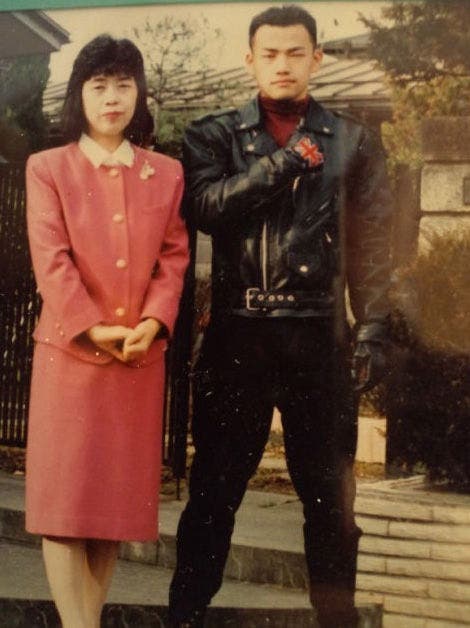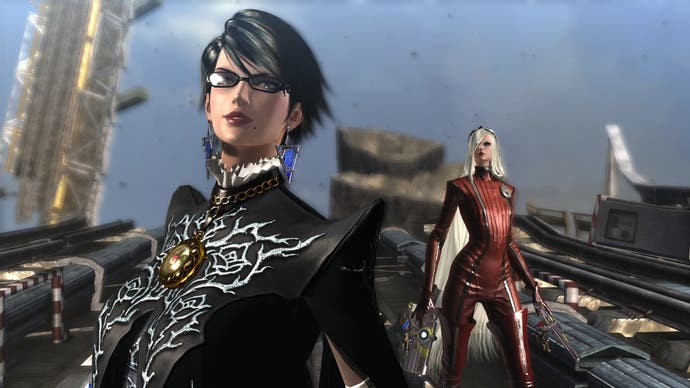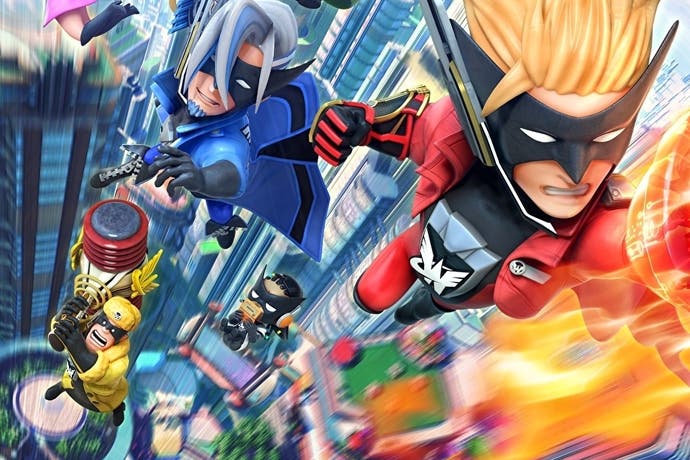The wonderful Kamiya
Up close and personal with the outspoken director.
You'd think he'd be terrifying. Hideki Kamiya, the creator of Devil May Cry, Bayonetta and Okami, has a persona that has come to light through his brilliantly candid and often terse Twitter outbursts and has been cultivated since before he got into games: there's a famous photo of a young Kamiya in a leather biker jacket, holding a Union Jack-gloved fist to his chest while a relative dressed in pink, perhaps his mother, stands politely beside him.
So you'd forgive me for being a little intimidated before sitting down with Kamiya a handful of days after reviews for his latest creation The Wonderful 101 have hit, and for having fears that any question I pitched that wasn't to his liking would be batted away with trademark pithiness. His press demonstrations, sometimes conducted in silence and only punctuated by occasional nods of approval from Kamiya, have become modest legends, his Twitter takedowns artfully harsh.

But in person, Kamiya's a pussycat. With shades perched on top of his closely shaved scalp and a promotional t-shirt spread across his wide frame, Kamiya sits attentively on the edge of a faux leather sofa giving thoughtful, measured answers (though I still daren't ask whether Bayonetta will be in Smash Bros.).
This isn't the scathing Kamiya who is ready to tear through fans, and there's not even the hard-edged, hardcore posturing that's defined so much of his work. Instead, this is Kamiya as he most likely really is, the softly spoken Nintendo fanboy who as a child queued up from 4am one cold New Year in the city of Matsumoto to get his hands on a Famicom, his first ever console.
This is the Kamiya who still has a wide-eyed love for video games, and who spends his time outside of work tracking down arcade boards to plug into his cabinet at home, where he pounds away on his prized possession, an original Gradius board. ("It cost a pretty penny," Kamiya says with pride. "I've got two of them, and I'll probably take them to my grave.") Kamiya's always had a soft spot for Nintendo - his iPhone's on the table before us wrapped in a case that mimics the iconic Famicom controller - and it was the Kyoto outfit that first sparked his desire to turn a passion for playing games into a talent for making them. Having failed to pass his high school entrance exam, it's the first place he applied to work for, although there's an element of Kamiya altering his story for the situation - when promoting Bayonetta he'd often say that it was Sega he first turned to.
Regardless of which version of that story's the truth, the love for Nintendo shines through in moments of The Wonderful 101, Platinum Games' first appearance on the Wii U. Just as Bayonetta had colourful nods to OutRun and Space Harrier, so too are there allusions to the many universes Nintendo's built, from the cameo of a Hylian shield to extended riffs on Punch Out. There was a time in the development of Wonderful 101 that the references weren't quite so subtle.
"Tatsuya Minami [Platinum Games' president and CEO] came to me with a request to create a game composed of an all-star cast including some Nintendo characters and some all-star characters," recalls Kamiya. "I wondered how I could satisfy all the fans and all the characters, and I wondered how I could create something that would fascinate all the fans of all the characters, so I thought why don't we put them all on screen at the same time? That was where the core concept that later turned into The Wonderful 101 came from."

The concept never came off and Kamiya went to work on another project, but when that stalled he decided to return to the original idea and get together a working demo on PC. The Nintendo characters had been ditched in favour of superheroes inspired by the likes of Kamen Rider - and lots of them. "That style of hero I find really interesting - usually it's just limited to five people or so, but with 100 of them they're impossible to defeat," says Kamiya. Their ability to morph together also drew inspiration from another childhood favourite, Dutch author Leo Linni's Swimmy, in which a school of fish combines to make one giant fish.
The Wonderful 101 was at first platform agnostic, though it was always slated to appear on a Nintendo machine. "I started thinking of ideas before thinking it was necessarily for any particular hardware," says Kamiya. "Once we showed it to Nintendo again and we reached an agreement - but we were never really thinking about a particular console at all."
"Before it was decided that it was going to be for Wii U, the core of the game had already been developed," Kamiya continues. "Only after that was it decided that we'd have this partnership with Nintendo. Once we had the opportunity to do something with the GamePad it provided us with some interesting opportunities - as developers it's something that really piques our curiosity."
It's an interesting marriage between Wonderful 101 and the Wii U, even if it's not a wholly successful one. There are strands from Kamiya's other games that all come together here - the art style of Viewtiful Joe, the combo strings of Devil May Cry and Bayonetta and the swirling inputs of Okami - but not all work perfectly. It's those inputs, carried out either on the GamePad's touchscreen or on its right stick, that have been the subject of most criticism.
"I can only really speculate about the problems that people are having, or why they're having them," says Kamiya. "But if I do speculate, I'll start by recognising that the game's really for core gamers - though there are elements that make it accessible. Personally, I find that using the stick is something more suited to the hardcore gamers, because if you take time to look down at the screen you lose time. If you're hardcore, use the stick and it'll be better - the screen's for people who aren't quite as hardcore."

If it's a problem, it's not one that's been created by a Nintendo keen to get Platinum to explore the eccentricities of its console. Kamiya says that Nintendo's involvement with The Wonderful 101 wasn't intrusive, their request for change kept to the bare minimum. "Before working with Nintendo I thought they were a big company and they'll have some big marketing guy telling them what to make, but once I started working with them I found the human side was deeper than I thought," he says. "You could have real conversations about how to make the game, and how to make it better."
"We were never really forced to do anything, but there was a dialogue and we got some pointers from Nintendo. The biggest thing was probably the graphical style - originally it was a bit darker. I wasn't really satisfied with it, and Nintendo said why don't you change it? Why don't you find something with a broader appeal, and the result's what you see now - it's a bit brighter, and it feels like action figures moving about in the game. I like the fact that Nintendo didn't ask to change too much - the creativity of Platinum was totally respected by Nintendo throughout the process."
That freedom's invaluable to Kamiya, and invaluable to the way that he works. Platinum, you sense, is a place where its open-plan office provides a unique kind of chaos from which these distinctive games emerge. And within that space, Kamiya's a unique power, placing a forceful and identifiable stamp on everything that's produced under his watch. Ask what exactly that stamp is, and what it is that defines a Kamiya game, and he struggles for an answer.

"It's difficult to say - if I was going to put something together, what's really important is I'm providing some direction to the team, and I'm in an environment where I can say what I want and do what I want. I'm not under the influence of marketing - which I don't have a particular affinity for - and a Kamiya game's what comes from being away from that kind of interference."
Speaking to Nintendo's Satoru Iwata recently, he provided a more succinct, more telling definition of his process and his style. "The core isn't in the plan from the start," he said. "We make the game with luck and inspiration, and if we work hard, at some point the God of Video Games descends upon us."
Nintendo's proven happy to support that chaos, and after Sega turned its back on Bayonetta 2, the Wii U's providing an unlikely home for the sequel. In something of a cruel trend in Kamiya's career, he won't be working directly on the sequel - Devil May Cry 2 was taken away from him, as were the follow-ups to Viewtiful Joe and Okami - but he's happy that it's taking the right direction. "I was working on 101 when discussion for a Bayonetta sequel started, so I'm not the director. At first I didn't know how to feel about that, but I'm in the same department and am in a supervisory role, so I'm sure the quality will meet my expectations."
The sales for Wonderful 101 may not have been great, but the support's enough to ensure the relationship should go on for a little longer. Kamiya's still keen to create a StarFox game in the future ("I can't really commit to anything - if I was going to work on anything like that it'd come with huge responsibility, so I can't say this lightly - but it's something that I really love, and I'm personally speaking a huge fan of the franchise"), but before then who knows what?
Kamiya's a hardcore gamer making hardcore games, and no matter where his next project takes him it's safe to say that much will remain. And no matter where the industry heads, there'll always be a place for the hardcore like Kamiya.
"I don't think they'll die out," he says gently. "I hope the spirit that I have, that my generation has, can be found in every generation. I'm sure it will continue."









